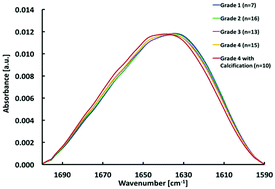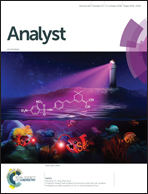Analysis of human menisci degeneration via infrared attenuated total reflection spectroscopy†
Abstract
Degeneration of human meniscal tissue induces impairment of normal knee functions, and is a highly relevant etiology of knee joint tears and osteoarthritis. Currently, the grading scale of meniscus degeneration is conventionally derived from evaluating meniscal morphology and histological staining. However, mid-infrared attenuated total reflectance (IR-ATR) spectroscopy is a particularly useful technique that may analyze the biomolecular composition at a sample surface, and provide information on the intra- and/or inter-molecular chemical bonds. In the present study, 61 lyophilized human menisci samples at different grades of degeneration were analyzed via IR-ATR spectroscopy in a label-free fashion, and the data were evaluated via Gaussian peak fitting and 2D correlation analysis. During increasing meniscal degeneration (i.e., grade 1 to 4) along with calcification at grade 4, an evident blue shift of the amide I band (1700–1600 cm−1) was observed in the associated IR spectra. In addition, Gaussian peak fitting revealed significant area variance of the fitted sub-peaks. 2D correlation spectra provided further access to detailed changes of the amide I band during the degeneration process. Derived from this multi-tiered data analysis taking into account the protein secondary structure information within the amide I band, and the triple helical structure of meniscal collagen, the blue shift and peak area changes during meniscus degeneration are indicative of collagen fibril formation during evolving degeneration. Furthermore, a degradation of the water-binding proteoglycan and collagen network especially for degenerated menisci with calcification was observed. Results were compared with a collagen–chondroitin sulphate mixture model, confirming the observed changes in collagen fibrils and proteoglycans. In summary, this study confirms the utility of IR-ATR spectroscopy as a versatile tool providing access to meniscal tissue degeneration processes at molecular level detail, and may in future evolve into a useful diagnostic instrument for analyzing cartilage degeneration.



 Please wait while we load your content...
Please wait while we load your content...